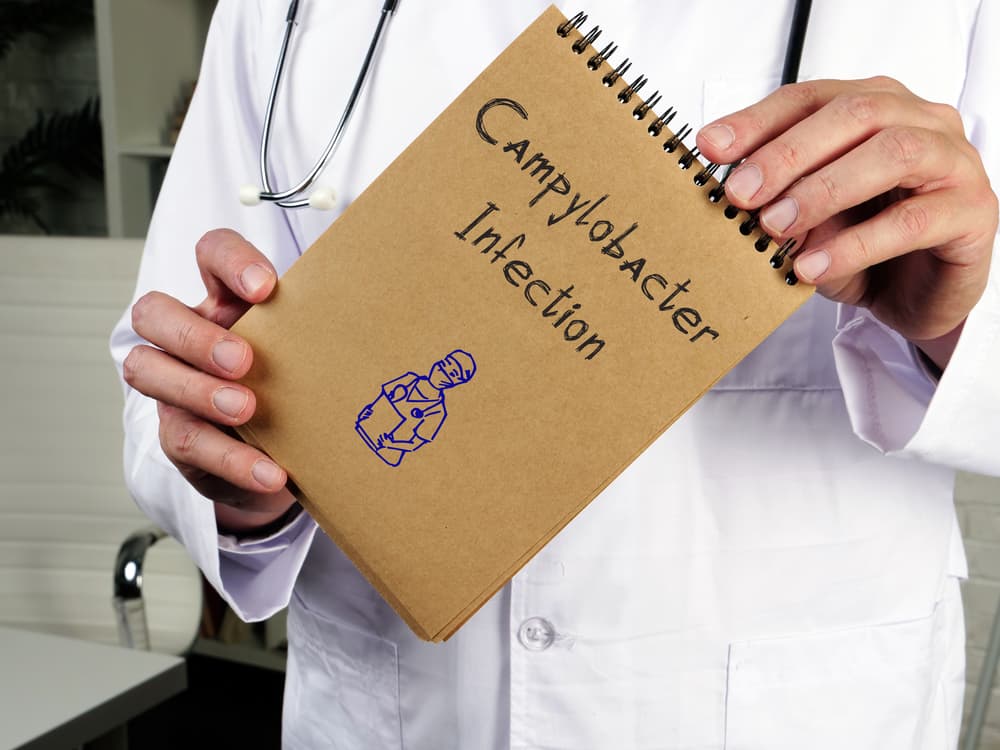Those who manufacture, prepare, or sell food to consumers in the U.S. have the legal duty to ensure that those products are safe. Unfortunately, greedy companies often put profit before safety, leading to widespread product recalls and potentially causing thousands of consumers to become ill.
The Centers for Disease Control and Prevention (CDC) estimates that around 1.5 million people in the U.S. suffer from preventable Campylobacter infections each year. For many, the infection will leave them with life-altering or even life-threatening impacts.
An attorney with experience in food poisoning cases is crucial to a compensated personal injury claim across the board, especially in food poisoning cases.
What Is Campylobacter?
Campylobacter is a bacteria found in most warm-blooded animals, including those commonly used for human consumption, such as poultry, cattle, and pigs. The bacteria commonly spreads to humans through uncooked or undercooked poultry or meat. Other sources of contamination include untreated drinking water and unprocessed milk.
The symptoms of Campylobacter infection, as noted by the CDC, include:
- Diarrhea, which is often bloody
- Fever
- Stomach cramps
- Nausea and vomiting
Though Campylobacter infections generally do not pass from human to human, the same food or water source can infect many individuals. Often, authorities can trace the outbreak’s source back to a restaurant or the manufacturing chain for meat, poultry, and other food products sold to consumers in grocery stores.
A CDC study found that Campylobacter contaminated 24 percent of the raw chicken sold in retail stores. It takes only a tiny amount of Campylobacter bacteria to make people sick, with a drop of raw chicken blood left on a cutting board enough to cause illness.
How Are Campylobacter Infections Diagnosed?
Campylobacter is generally diagnosed through a stool culture, though sometimes doctors will use a blood or spinal fluid culture. Additionally, the Health Department will study the patient’s food history if it suspects Campylobacter. While many Campylobacter infections are sporadic, sufferers often acquire the infection through food handling in a private setting. Health departments will examine the results of Campylobacter cultures and can sometimes link the infection to an outbreak.
What Are the Impacts of Campylobacter Infections?
The symptoms of Campylobacter infection generally appear within two to five days of consumption of the bacteria through either raw meat, poultry, shellfish, or other foods or beverages that have come in contact with the bacteria.
Most people will recover from the illness within about a week, often without antibiotics. However, the CDC notes that some people will experience complications from the illness, such as irritable bowel syndrome, temporary paralysis, or even arthritis. The bacteria can spread to the bloodstream and cause a life-threatening infection.
Each year in the U.S., the CDC explains, between 3,000 and 6,000 people will acquire Guillain-Barré Syndrome (GBS), a serious medical condition in which the patient’s immune system harms their body’s nerves. The symptoms of GBS include weakness and tingling that generally starts in the legs and can also involve the arms and body. These symptoms can progress for days, weeks, or even several months.
Recovery can take months to years. Campylobacter infections are a major contributor to GBS, with the CDC reporting that many patients suffer diarrhea several weeks before GBS symptoms appear. It is believed that Campylobacter is responsible for up to eight in every 20 GBS diagnoses in the U.S. yearly, with GBS being more common in men and adults over 50.
A Campylobacter infection will generally result in lost time from work or school during the illness. Those who acquire complications face further interruptions to their daily lives and significantly higher expenses due to laboratory testing, hospitalization, medical treatments designed to remove the bacteria from the blood, and more.
These infections are commonly most serious to people with weakened immune systems, such as those with blood disorders, AIDS, or who are receiving chemotherapy. Campylobacter infections and GBS caused by a Campylobacter infection can even lead to death in some cases.
According to the United States Department of Agriculture (USDA), two percent of GBS patients will die from the illness, and up to 65 percent will suffer neurological pain and other lingering disabilities, including abnormalities of the nervous system, changes to heart rate and blood pressure, as well as changes to vision and body temperature.
The USDA estimates the overall societal cost of Campylobacter infections and GBS are up to $8 billion a year. This calculation does not consider the pain and suffering experienced by patients, the loss of earning capacity incurred due to permanent impacts from the condition, time spent traveling to medical appointments, and the loss of the ability to enjoy hobbies and activities.
Regulations Designed to Cut the Number of Campylobacter Cases in the U.S.
Campylobacter contamination in the U.S. is one of the leading causes of diarrheal infections. Because the bacteria is so potent, there is a patchwork of federal and state agencies who work to control outbreaks and protect consumers by providing standards in the processes used to procure raw meats and shellfish and make them available for retail purchase.
Some of the agencies involved in this effort include:
- The USDA oversees the meat, dairy, and poultry industry. The USDA is responsible for implementing best practices on farms and advocates for the pasteurization of dairy products and treatment of municipal water supplies to eliminate common routes of contamination of foods and beverages. Additionally, the USDA monitors manufacturing facilities that process meat, poultry, and dairy products to ensure safe practices that avoid spreading bacteria. When a food product is recalled, the USDA’s Food Inspection Safety Service conducts effectiveness checks to ensure that the recalling firm has contacted distributors and retailers to make them aware of the issue.
- The Food and Drug Administration (FDA) oversees other foods, as well as medications. The FDA is also tasked with investigating Campylobacter outbreaks through their Coordinated Outbreak Response and Evaluation (CORE) Network and coordinating the post-outbreak response of the various federal agencies.
- The CDC also has a hand in managing outbreaks to control the spread of infectious diseases from contaminated food. They also investigate outbreaks, providing the information needed by the FDA to determine if recall of a certain product is warranted.
- The Minnesota Department of Agriculture oversees the safety of foods sold in grocery stores or manufactured in the state. On most issues, the Minnesota Department of Ag’s rules are as strict—if not more strict—than those imposed on manufacturers, producers, and retail stores by federal agencies.
- The Minnesota Department of Health investigates outbreaks of all types of illnesses within the state and reports the numbers and types of illnesses suffered in the state to the CDC. The Department of Health is often involved in investigating suspected restaurant outbreaks and collaborates with other agencies to control these outbreaks.
- City and county health departments enforce the Minnesota food code in restaurants.
Seeking Compensation for Campylobacter Food Poisoning
As noted, Campylobacter food poisoning is not always simply a matter of not feeling well for a week. The complications experienced as a result of Campylobacter infection can be financially and emotionally devastating. If you’ve suffered medical expenses, wage loss, and psychological costs after acquiring a foodborne Campylobacter infection, you can seek compensation for these monetary and quality-of-life costs through a product liability claim.
Product liability is an area of law that deals with the legal responsibility that the producers and manufacturers of products—including foods—have to ensure that the products they sell are reasonably safe when used as intended.
Depending on the source of the bacteria that caused your infection, you can seek compensation.
- If you acquired a Campylobacter infection from food that you consumed in a restaurant, an experienced product liability lawyer can file a compensation claim against the restaurant’s business liability insurance policy. This is a common process that, while being extraordinarily difficult for someone to manage on their own, is relatively straightforward in most cases for an experienced food safety attorney.
- If your infection stemmed from a product you purchased in a retail store, the situation grows more complex. The health department will review the patient’s food history if a stool culture confirms a foodborne illness. If they link the illness to a particular product, the FDA will often, but not always, issue a product recall to make others aware. The companies behind these cases are often major, global brands that have the resources to hire strong defense attorneys to fight the claim. You will need a personal injury lawyer who can convince them of the strength of your claim and the reasonableness of your demand for compensation.
What Do I Need to Prove in a Campylobacter Food Poisoning Case?
In most types of personal injury cases, to obtain compensation for harm through the personal injury claims process, the claimant and their attorney must be able to prove that the injury was incurred as a result of negligence. This requires showing that the harm was the direct result of the breach of the legal duty that the at-fault party had in a certain set of circumstances. However, product liability claims typically feature strict liability.
What strict liability means is that the at-fault party is liable for compensating those who were harmed by the product, even if they were not careless or reckless (negligent) in the production or manufacturing processes involved in making that product available for consumers and did not have reason to know that Campylobacter bacteria contaminated the product.
Instead, an attorney can help you gather the information from the agencies who investigated and reported your illness and other evidence linking the harm you experienced to the contamination of a specific product. Often, that other evidence involves recalls for the product issued by the FDA and reports of an outbreak that was investigated and confirmed by local, state, or federal authorities.
What Type of Compensation Is Available in a Campylobacter Claim?
The expenses and the psychological impacts of incurring a bacterial infection and potentially an array of long-term complications can be overwhelming, even for those with the best insurance. The personal injury claims process allows individuals who have incurred a Campylobacter infection due to contaminated food that they bought from the store or consumed in a restaurant allows claimants to seek both economic and non-economic damages.
Economic damages refer to compensation for the expenses of your illness, such as emergency room treatment, hospitalization, the provision of medications, and medical attention for complications. This area of compensation also involves wage loss due to being too ill from the contamination to work and permanent loss of earning capacity experienced as a result of Campylobacter infection complications, such as GBS.
Non-economic damages refer to compensation for the psychological impacts you experienced due to the illness, such as physical pain and suffering, emotional distress, inconvenience, humiliation, and other quality-of-life impacts.
Why You Need an Attorney to Assist You With Your Campylobacter Food Poisoning Claim

When individuals attempt to file a claim seeking compensation for harm, they quickly run into several potential obstacles, including:
- Insurance companies, major manufacturers, and defense attorneys all have abundant experience in dealing with cases like these and avoiding paying out on the claim
- Difficulty knowing the type of evidence needed to prove the claim and how to gather and present that evidence
- An overwhelming legal process in which court formalities and requirements must be met, even if the person engaging in the process doesn’t know what those formalities and requirements are.
- Lack of understanding as to how to value the claim to receive the compensation needed to cover the expenses and impacts of the illness
Having an experienced attorney and their legal team on your side helps to level the playing field and increase your chance of receiving compensation for your Campylobacter food poisoning claim.
